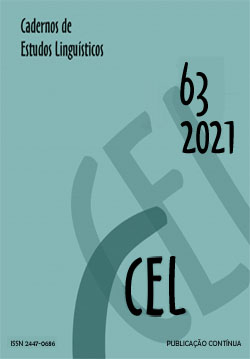Abstract
Este artículo investiga cómo el aumento de la tasa de elocución actúa para cambiar articulatoriamente los movimientos verticales de la mandíbula. Dos mujeres (una de Minas Gerais y otra de São Paulo) en el grupo de edad de 30-40 años fueron grabadas en el Laboratorio de Fonética de la Universidad del Espiritu Santo con el uso de un magnetómetro NDI Wave con una frecuencia de muestreo de 100 Hz. Los resultados muestran que el aumento de la tasa de elocución alteró los parámetros articulatorios en el eje vertical de la siguiente manera: a) disminución de la duración de la aceleración; b) disminución del punto vertical máximo (y-extremo); c) disminución del desplazamiento de la constricción; d) disminución en módulo de la velocidad del valle/pico; e) disminución de la duración de los gestos articulatorios; y f) tiempo-para-velocidad-de-pico/valle proporcional constante. Además, los resultados muestran que la tasa de elocución tiende a afectar todos los gestos independientemente de su posición frasal. Sin embargo, hay evidencias que algunos parámetros articulatorios, si debidamente controlados, pueden proporcionar indicios para reestructuraciones rítmicas del habla.
References
ALBANO, E. C. & MOREIRA, A. A. (1996). Archisegment-based letter-to-phone conversion for concatenative speech synthesis in Portuguese. Proceedings ICSLP'96, v.3, 1708-1711.
BARBOSA, P. A. (1994). Caractérisation et génération automatique de la structuration rythmique du français, PhD Thesis, ICP/INP in Grenoble, France.
BARBOSA, P. A. (2002). Explaining Cross-Linguistic Rhythmic Variability via a Coupled-Oscillator Model of Rhythm Production. In BEL, B. & MARLIEN, (Eds.). Proceedings of the Speech Prosody 2002 Conference, 11-13 April, Aix-en-Provence: Laboratoire Parole et Langage, 163-166.
BARBOSA, P. A. (2006). Incursões em torno do ritmo da fala. Campinas, São Paulo: Pontes Editores, Fapesp.
BARBOSA, P. A. (2007). From syntax to acoustic duration: a dynamical model of speech rhythm production. Speech Communication. 49 (1-2), 725 - 742.
DAUER, R. M. (1983). Stress-timing and syllable-timing re-analysed, Journal of Phonetics 11, 51-62.
FRAISSE, P. (1974). La psychologie du rythme, Paris: Presses Universitaires de France.
KELSO, J. A. S. (1995). Dynamic Patterns: The Self-Organization of Brain and Behavior. Cambridge: MIT Press. [Paperback edition, 1997].
KELSO, J. A. S., SALTZMAN, E. L., & TULLER, B. (1986). The dynamical perspective on speech production: data and theory. Journal of Phonetics 14, 29-59.
LEHISTE, I. (1970). Suprasegmentals. MIT Press, Cambridge.
LEHISTE, I. (1978). Temporal organization and prosody: perceptual aspects. In Joint Meeting of A.S.A. and A.S.J.1, Honolulu, 1-17.
MARCUS, S. M (1976). Perceptual-centres.Unpublished PhD Thesis, Cambridge University.
MASSINI, G. (1991). A duração no estudo do acento e do ritmo do português. Campinas: Iel/Unicamp, MD.
MASSINI-CAGLIARI, G. (1992). Acento e Ritmo. São Paulo: Contexto.
MATTOSO CÂMARA Jr., J. (1970). Estrutura da língua portuguesa. Petrópolis: Vozes.
MEIRELES, A. R. (2009). Self-organizing rhythms in Brazilian Portuguese: speech rate as a system perturbation. Germany: VDM Verlag, 2009.
MEIRELES, A. R. & BARBOSA, P. A. (2008). Speech rate effects on speech rhythm. In: Speech Prosody 2008 Conference, 2008, Campinas. Proceedings of the Speech Prosody 2008 Conference. Campinas: RG. v.1. p.327 – 330, 2008.
MEIRELES, A. R. & BARBOSA, P. A. (2014). Articulatory Reorganizations of Speech Rhythm due to Speech Rate Increase in Brazilian Portuguese. In: Speech Prosody 2014, 2014, Dublin, Irlanda. Proceedings of Speech Prosody 2014, 2014.
MEIRELES, A. R. & GAMBARINI, V. P. (2012). Rhythm Typology of Brazilian Portuguese dialects. In: Speech Prosody 2012, 6h International Conference on Speech Prosody, 2012, Shanghai. Proceedings of Speech Prosody 2012, 2012.v. 1.
MEIRELES, A. R., TOZETTI, J. P. & BORGES, R. R. (2010). Speech rate and rhythmic variation in Brazilian Portuguese. In: Speech Prosody 2010 Conference, 2010, Chicago. Proceedings of the Speech Prosody 2010 Conference. Chicago: RG. v.1. p.1-4, 2010.
MORTON, J., MARCUS, S. & FRANKISH, C. (1976) Perceptual-centers (P-centers), Psychological Revue 83 (5), 405-408.
PERKELL, J., COHEN, M., SVIRSKY, M., MATTHIES, M., GARABIETA, I. & JACKSON, M. (1992). Electro-magnetic midsagittal articulometer (EMMA) systems for transducing speech articulatory movements. J. Acoustical Soc. America 92, 3078-3096.
POMPINO-MARSCHALL, B. (1991). The syllable as a prosodic unit and the so-called P-centre effect. Munique, Alemanha.
SILVA, J. de A. & MEIRELES, A. R. (2011). Sociophonetic study of the Capixaba speech rhythm. Journal of Speech Sciences 1(1):3-13. 2011. Available at: http://www.journalofspeechsciences.org.
TIEDE, M. K., VATIKIOTIS-BATESON, E., HOOLE, P. & YEHIA, H. (1999). Magnetometer data acquisition and analysis software for speech production research. ATR Technical Report TR-H 1999. Kyoto, Japan: ATR Human Information Processing Labs.
WOODROW, H. (1951). Time Perception. In STEVENS, S. S., editor, Handbook of Experimental Psychology, 1224-1236. Wiley, New York.

This work is licensed under a Creative Commons Attribution-NonCommercial 4.0 International License.
Copyright (c) 2021 Cadernos de Estudos Linguísticos


